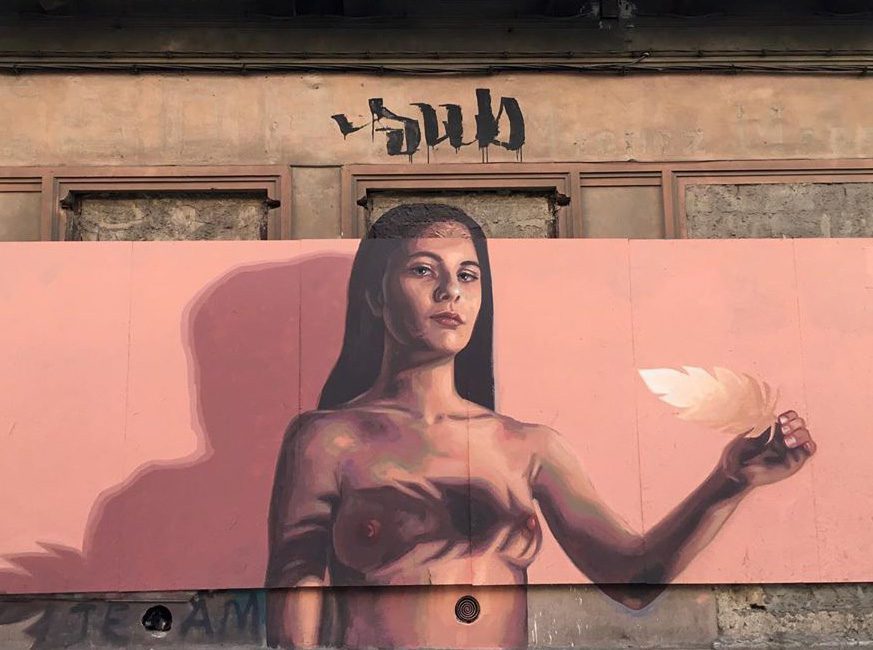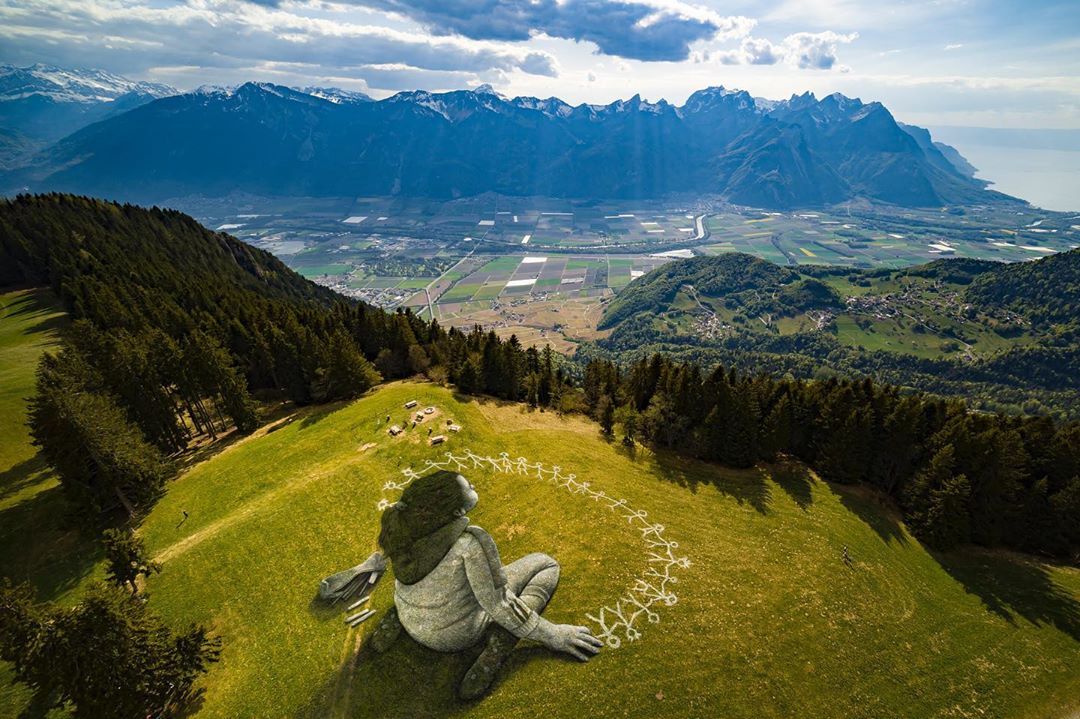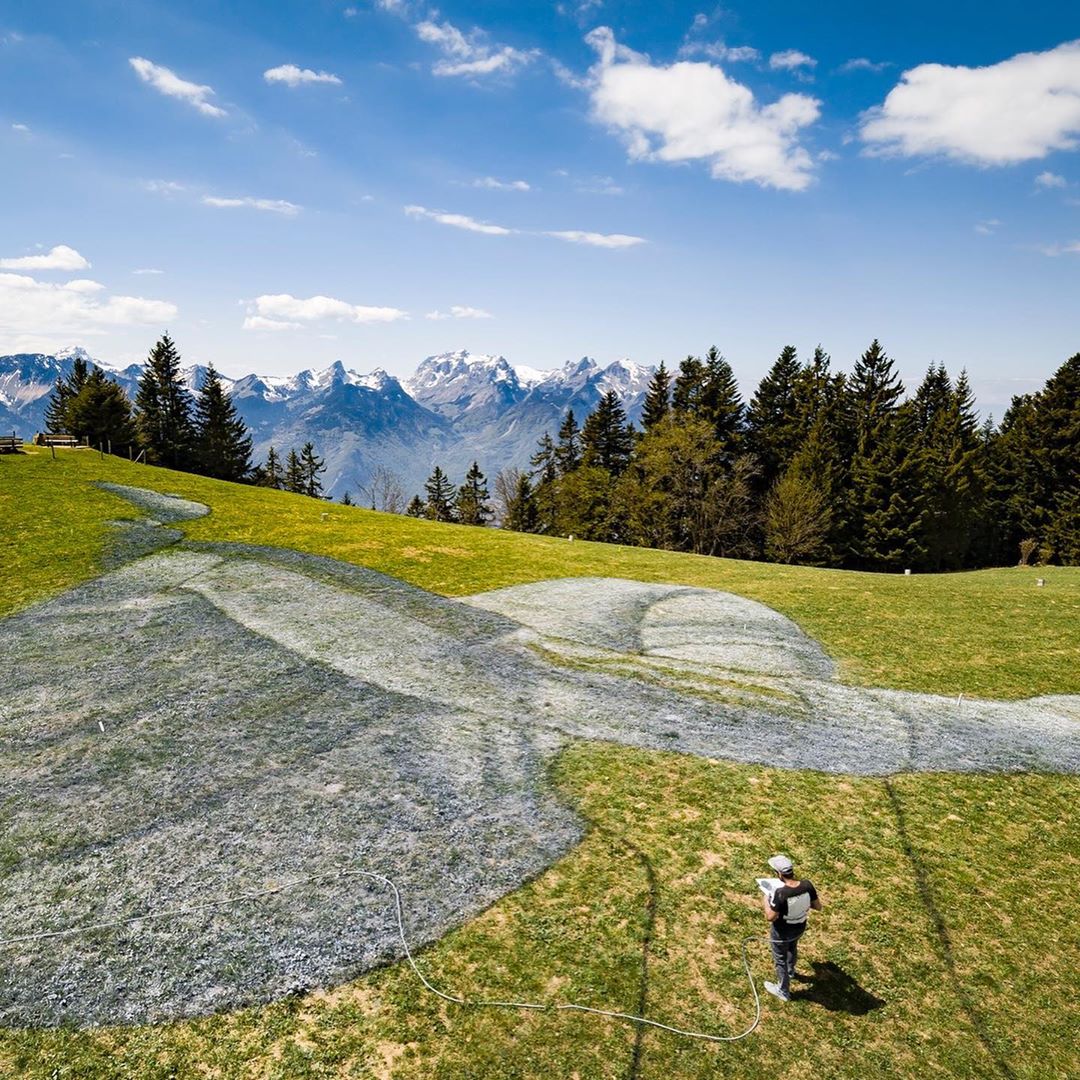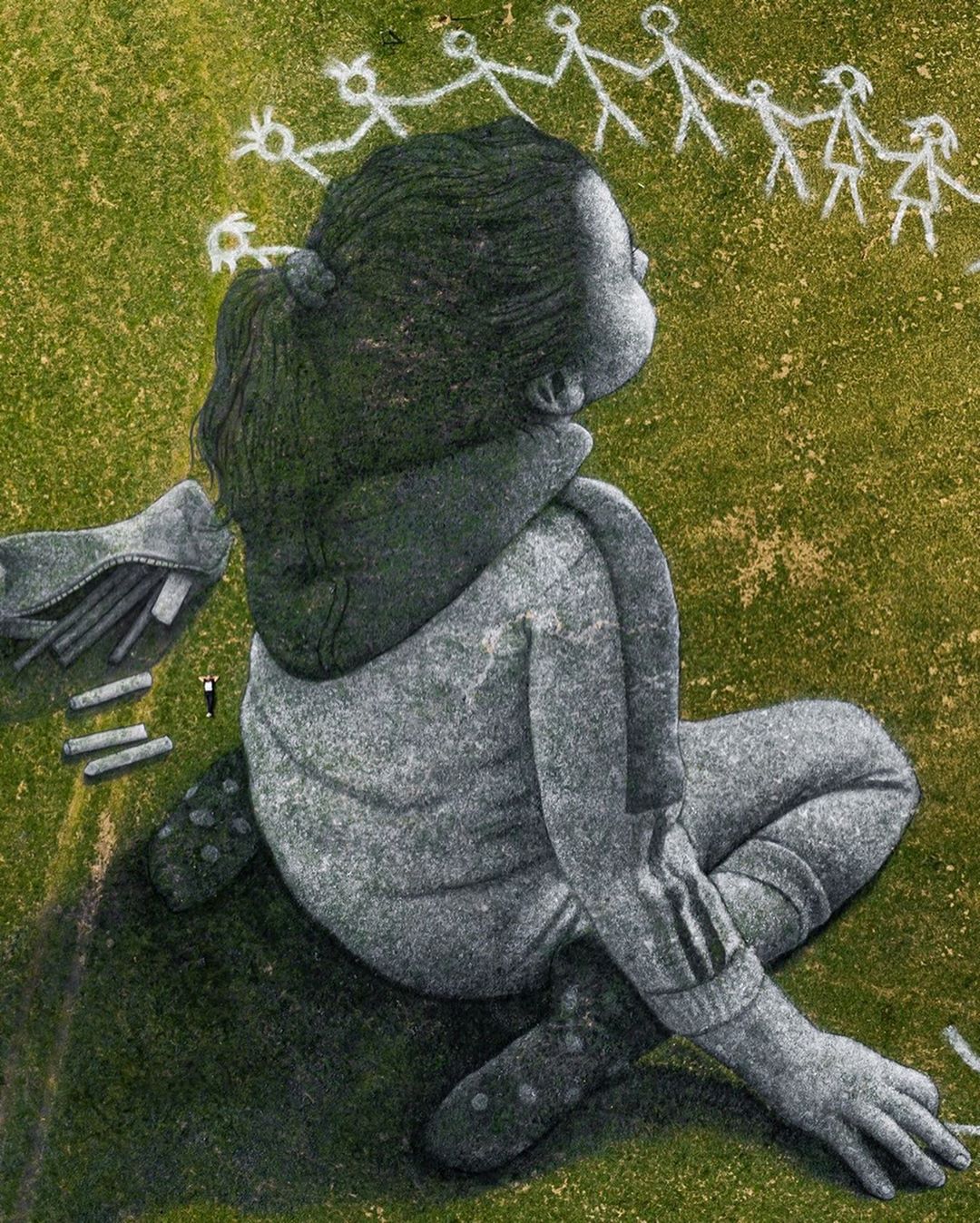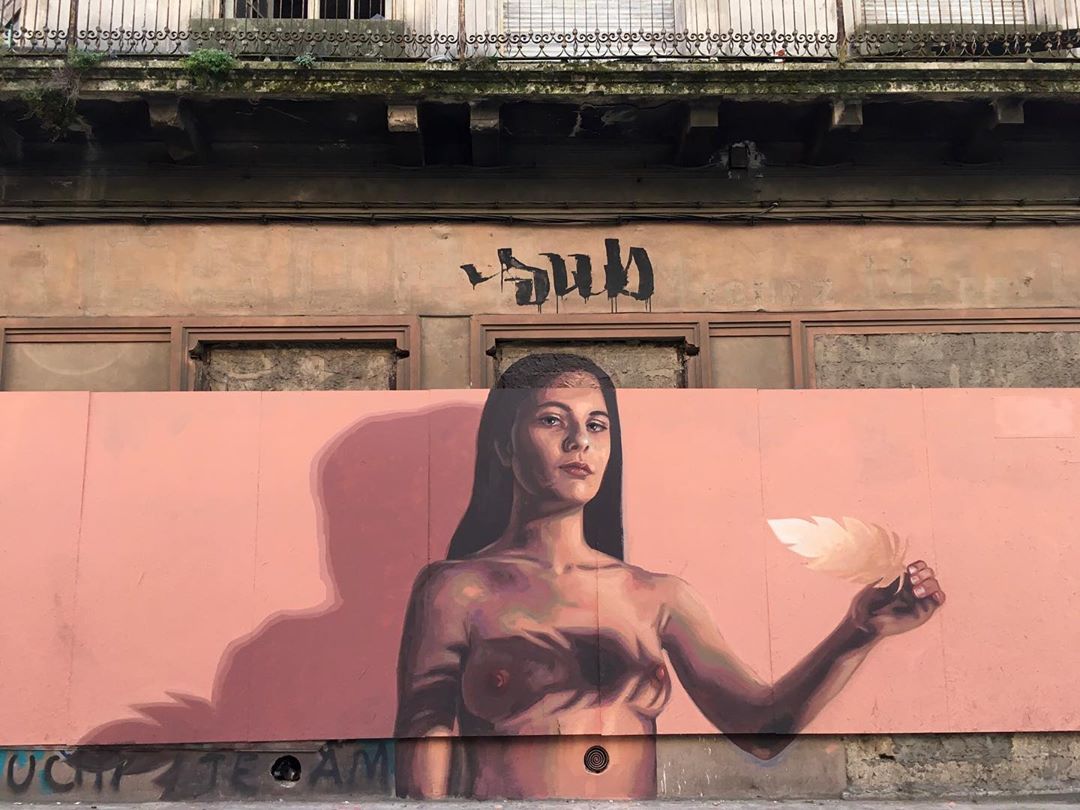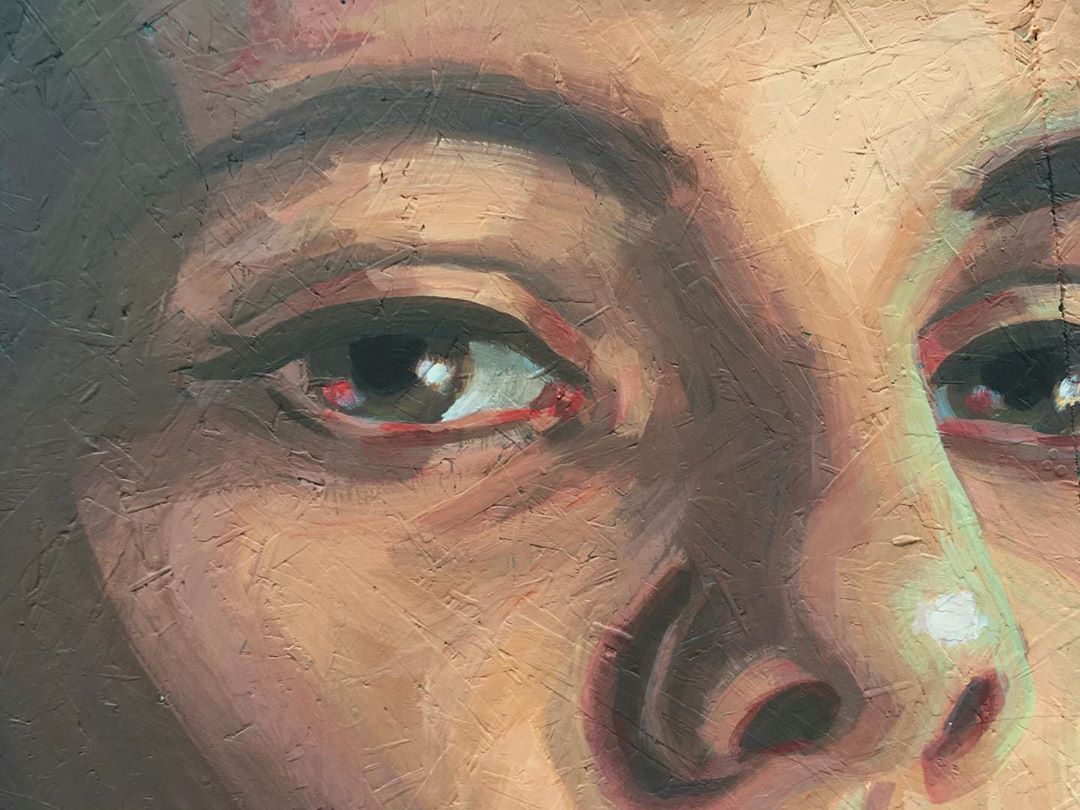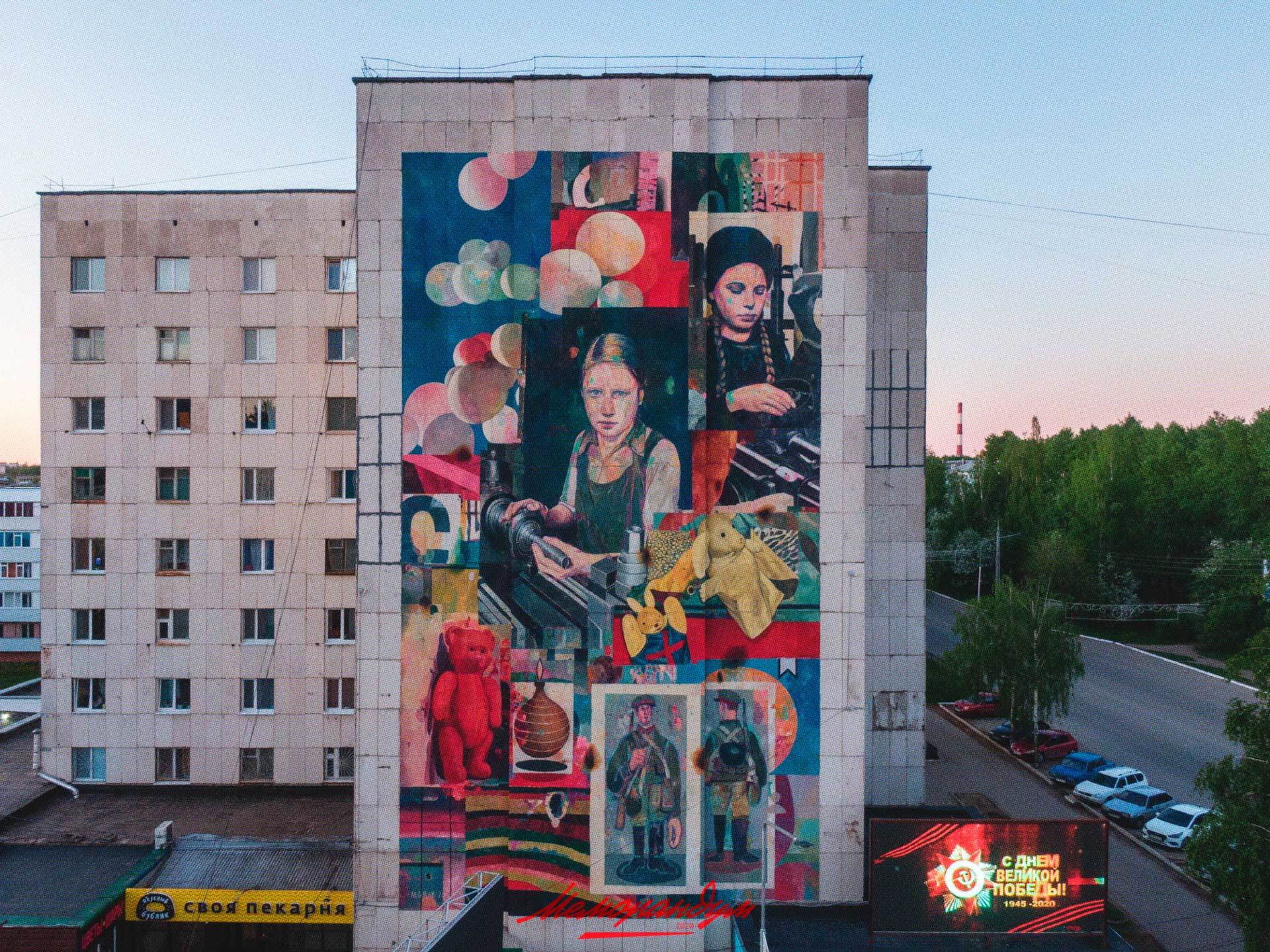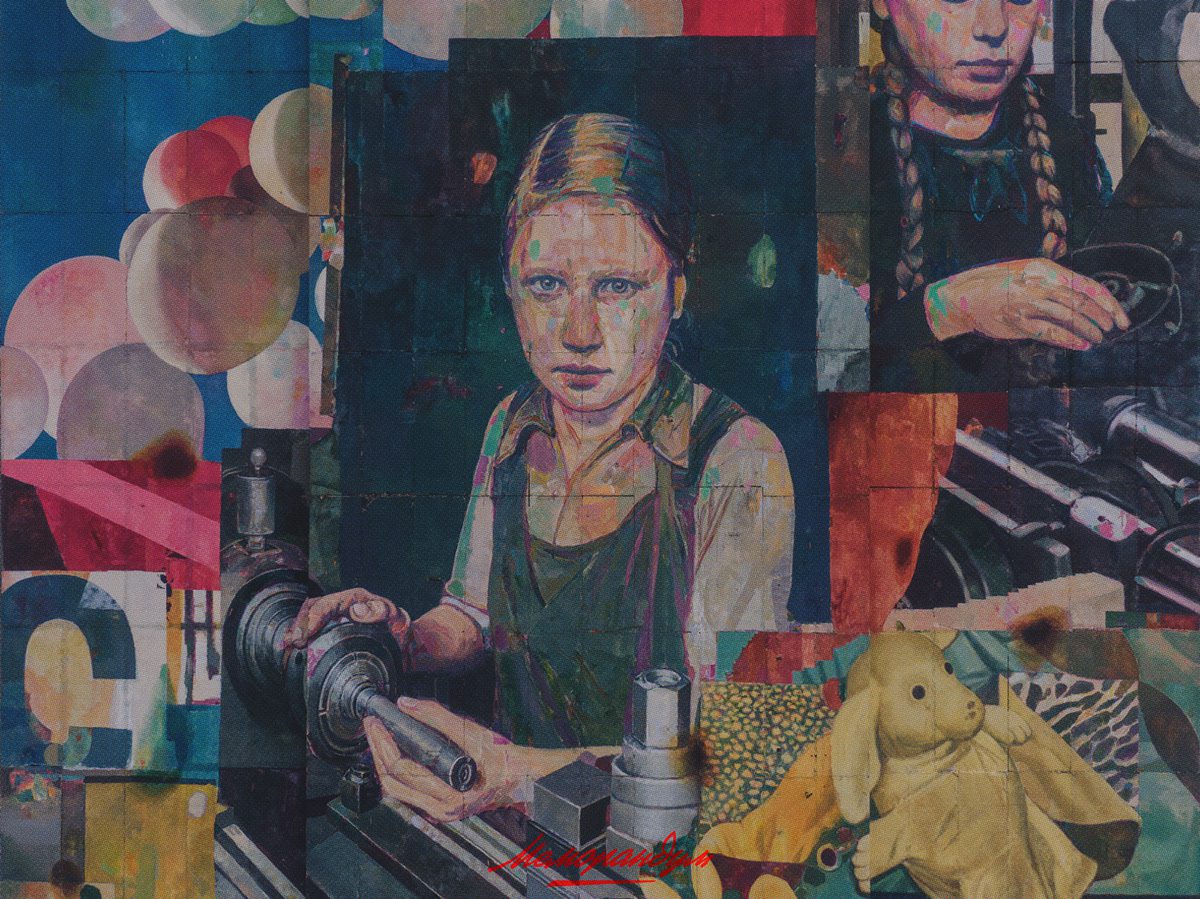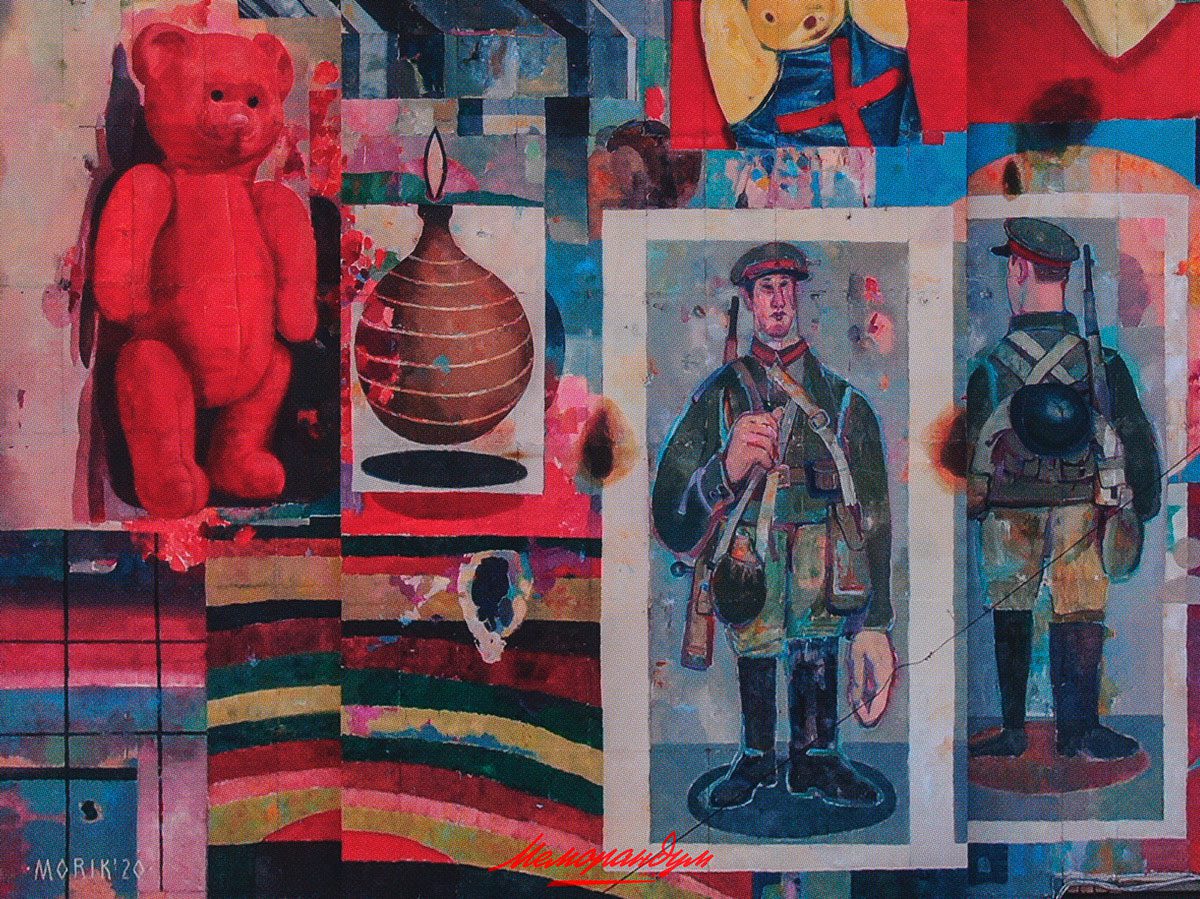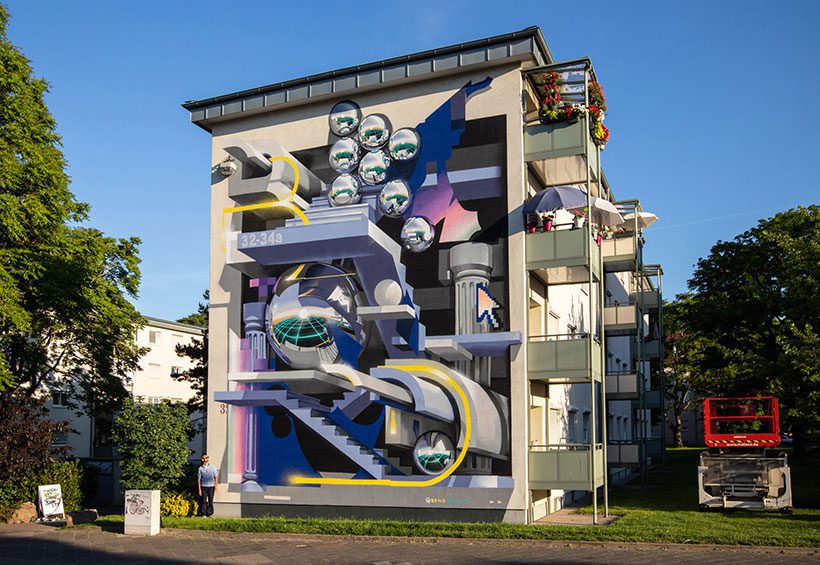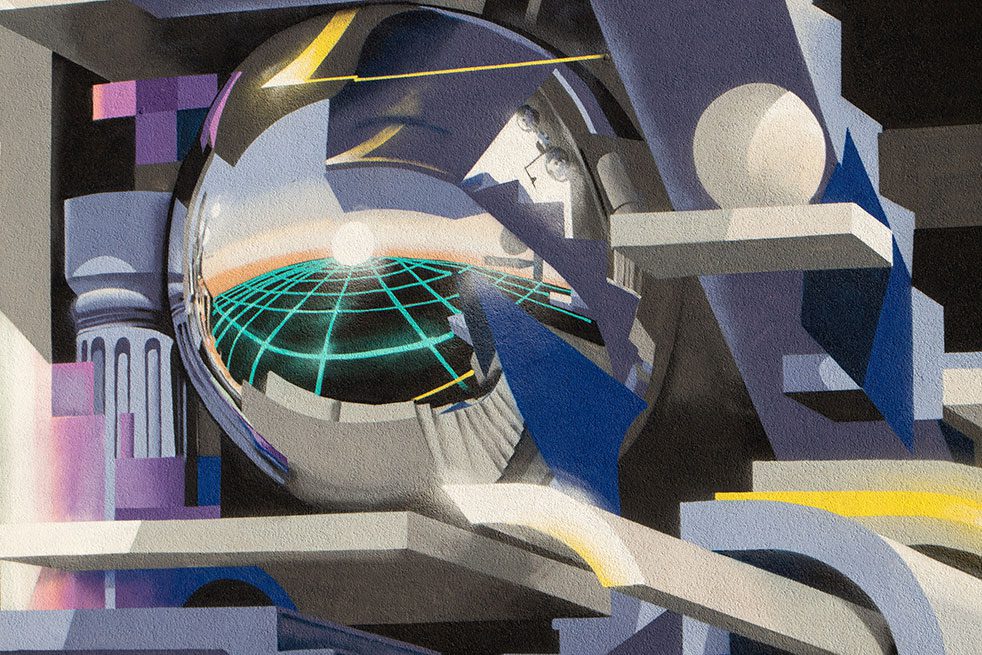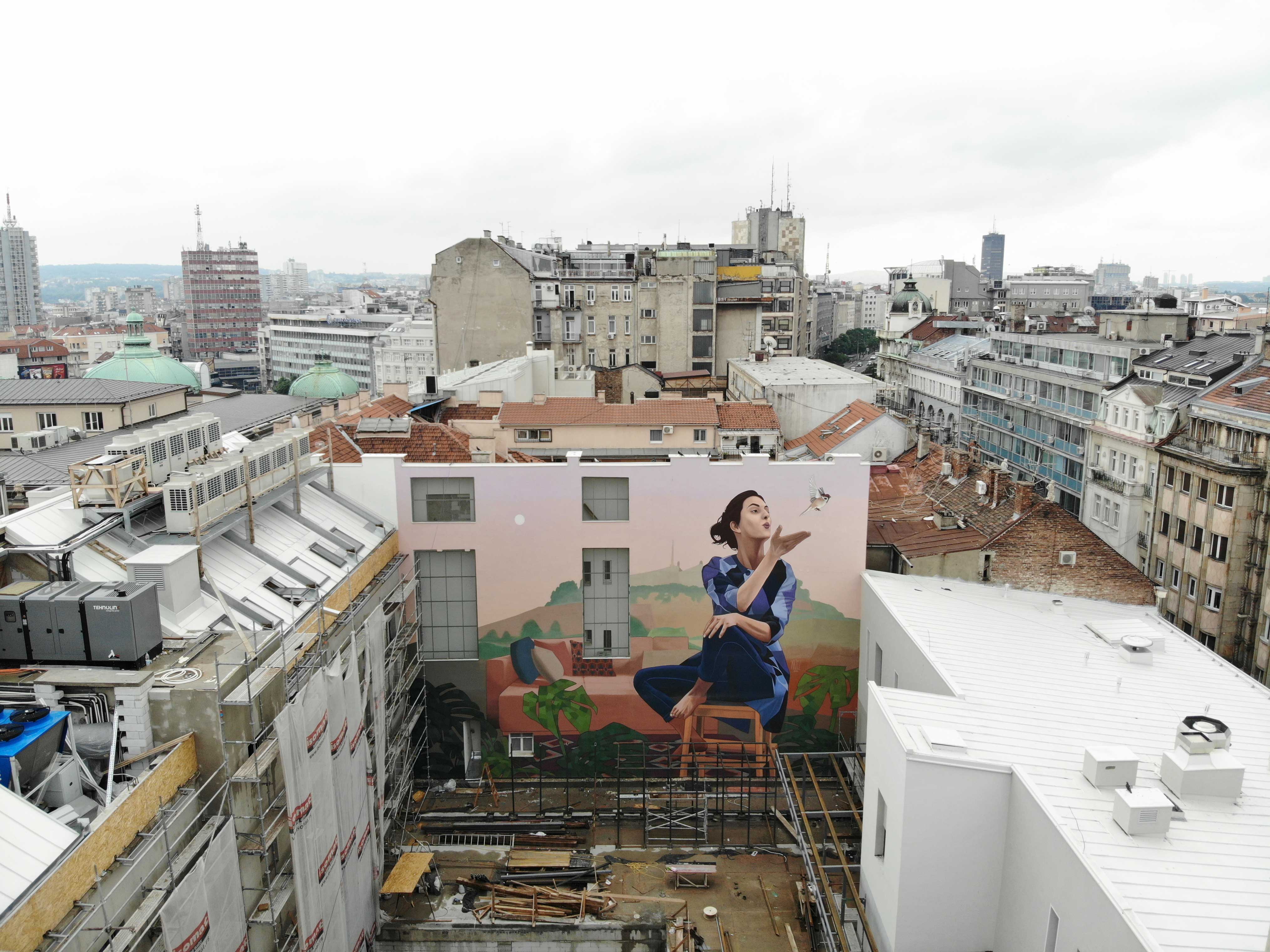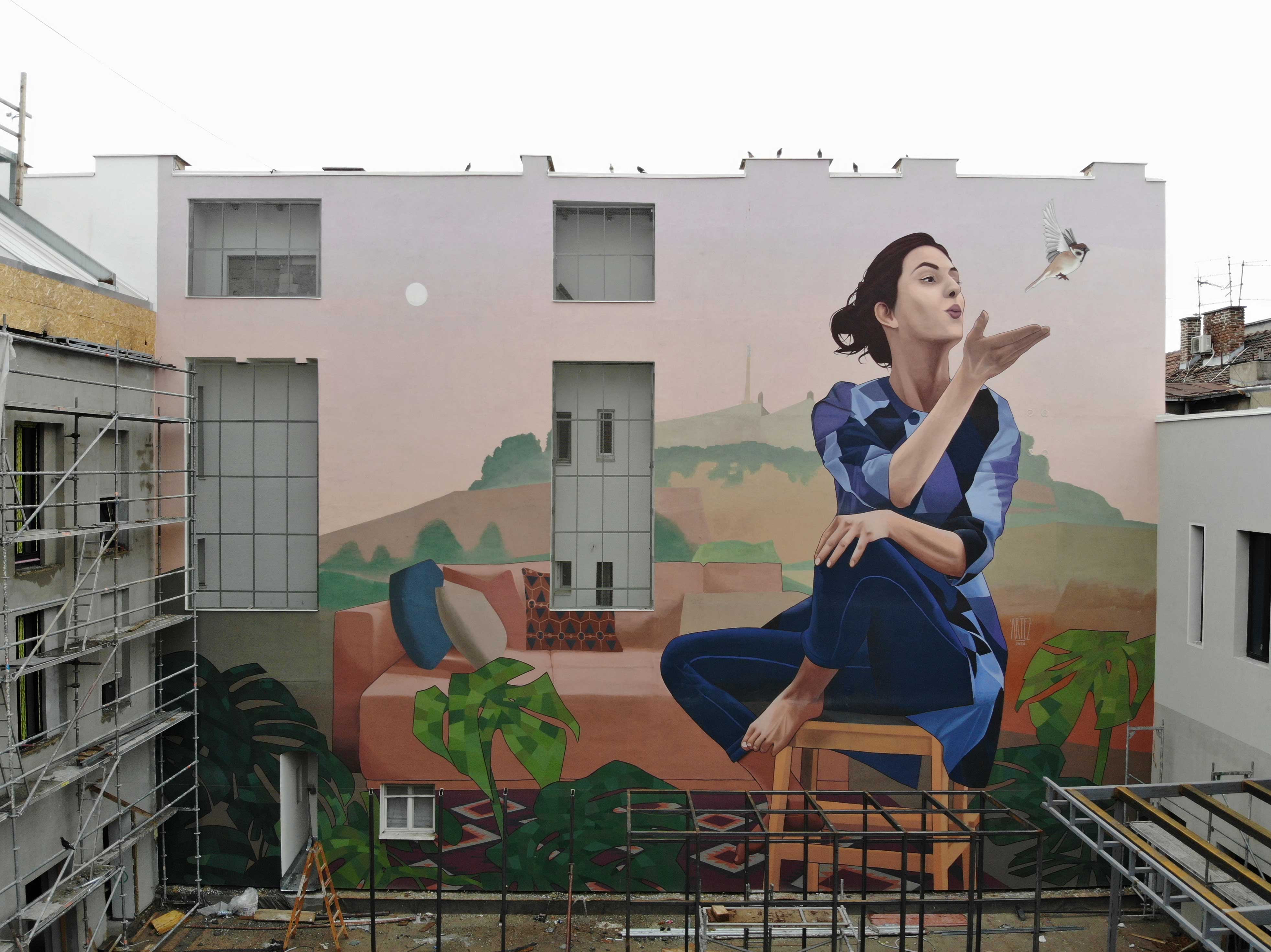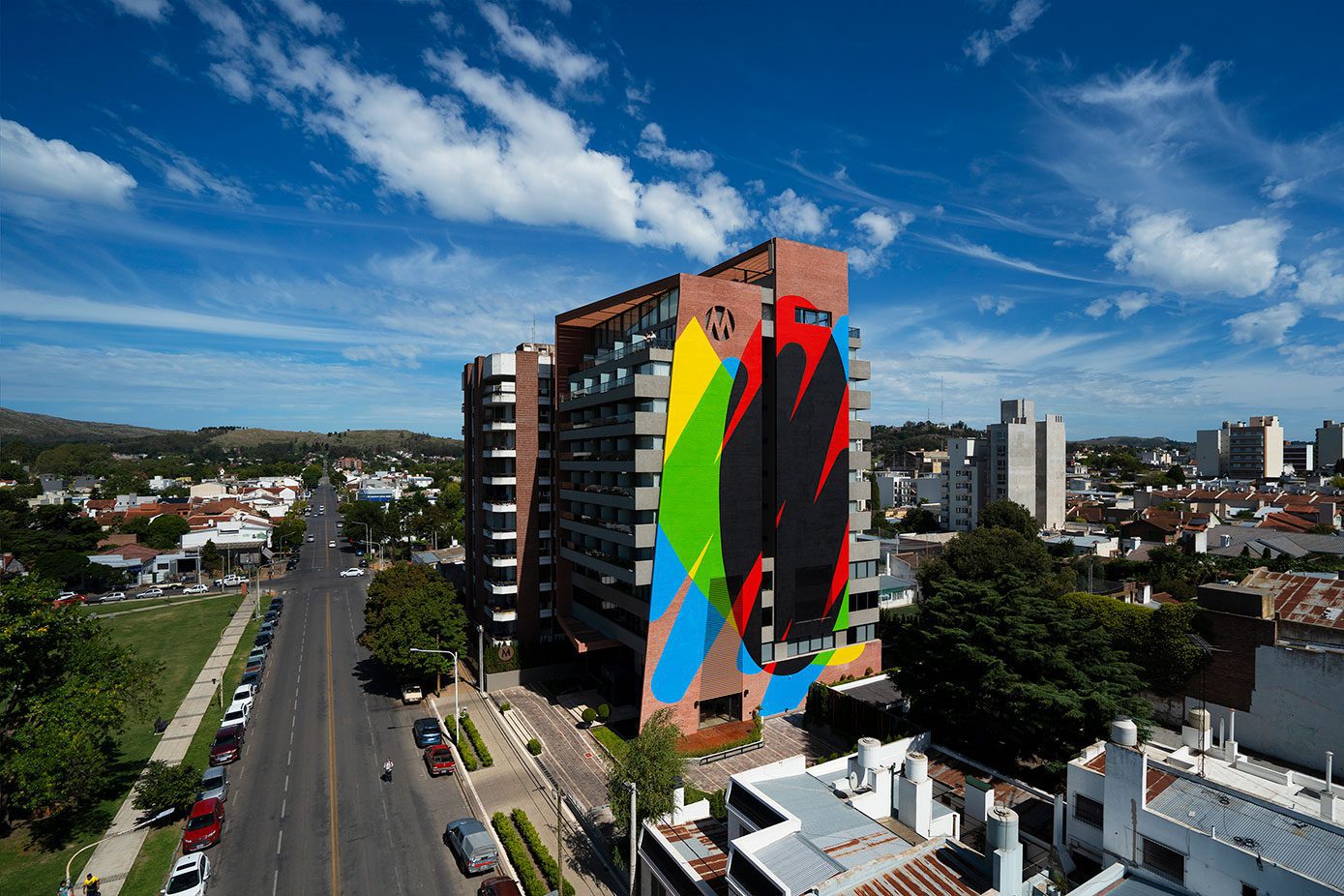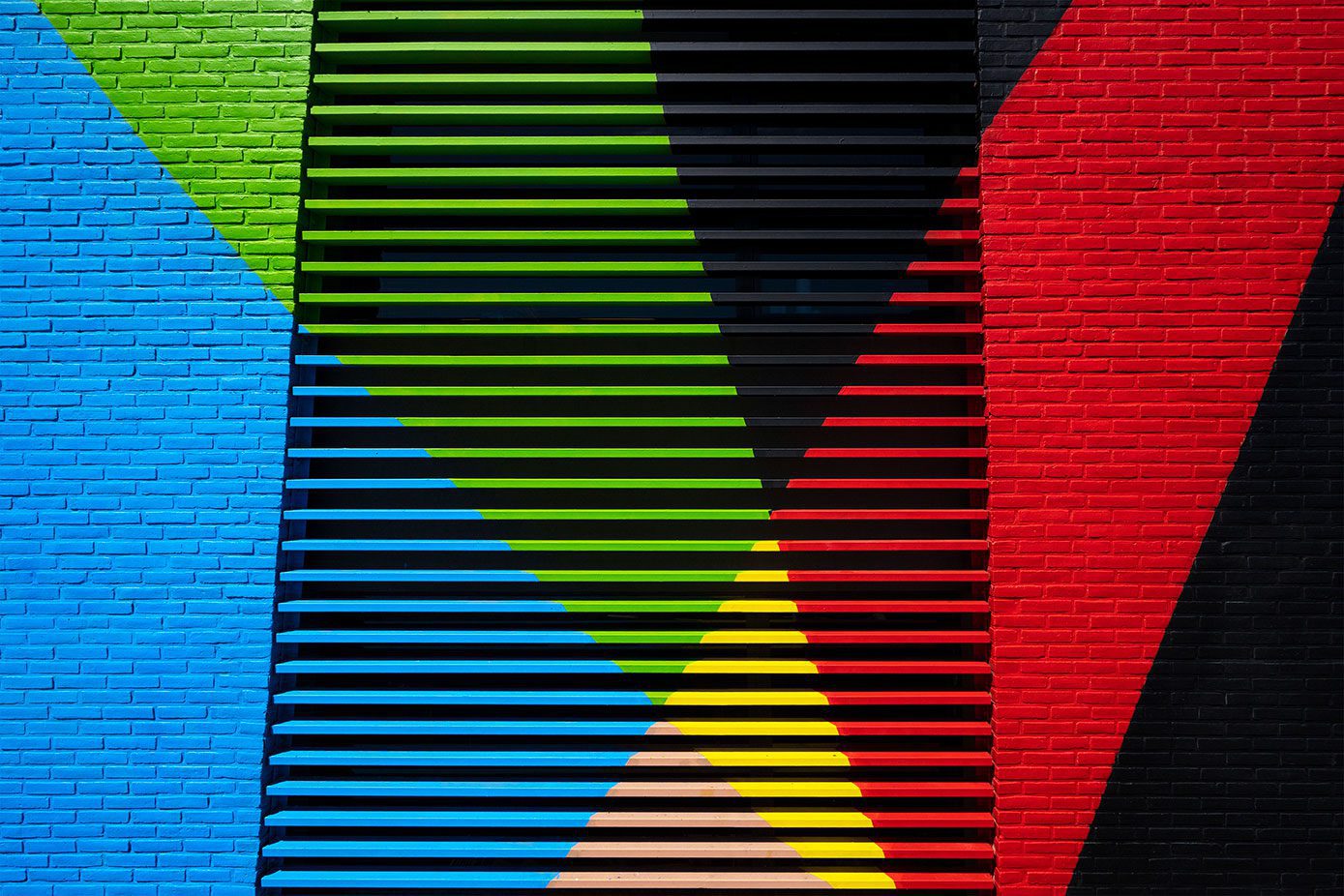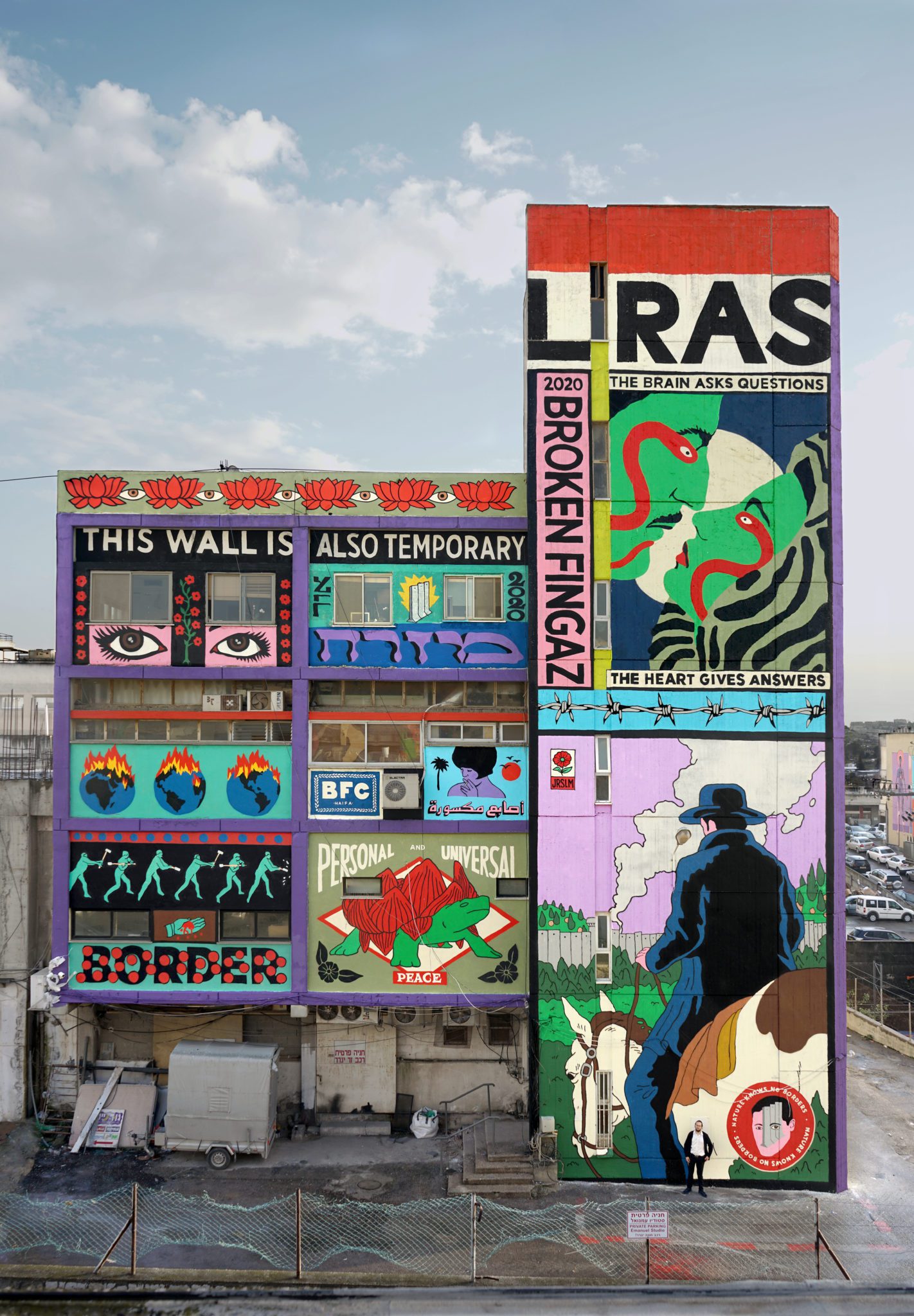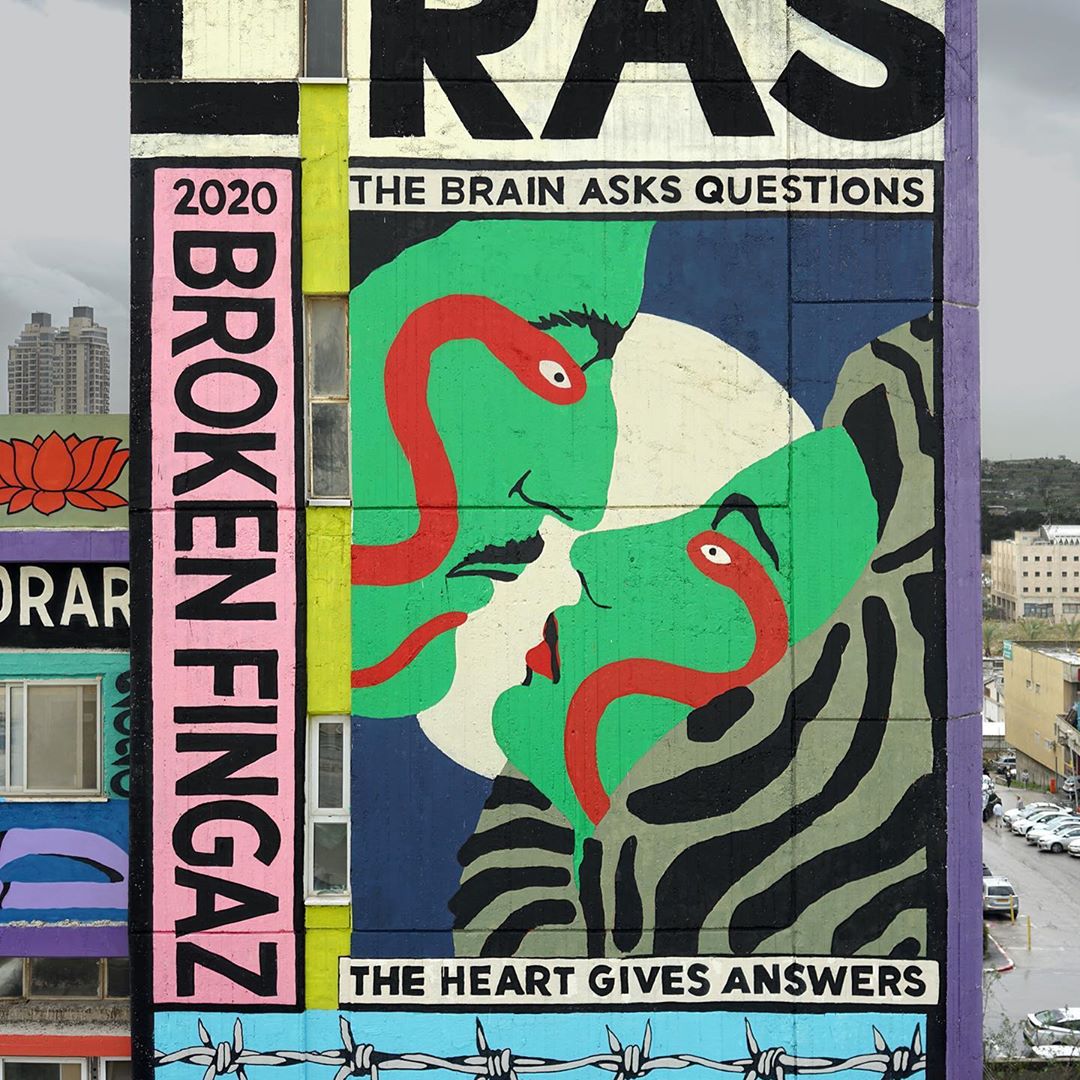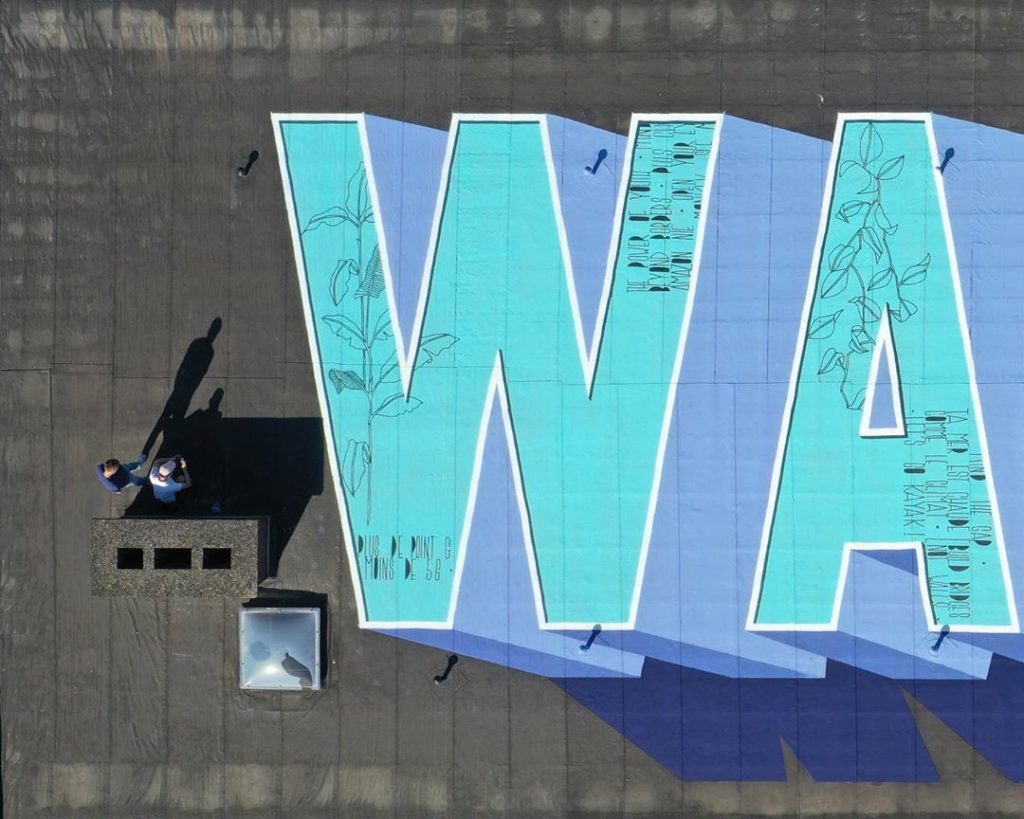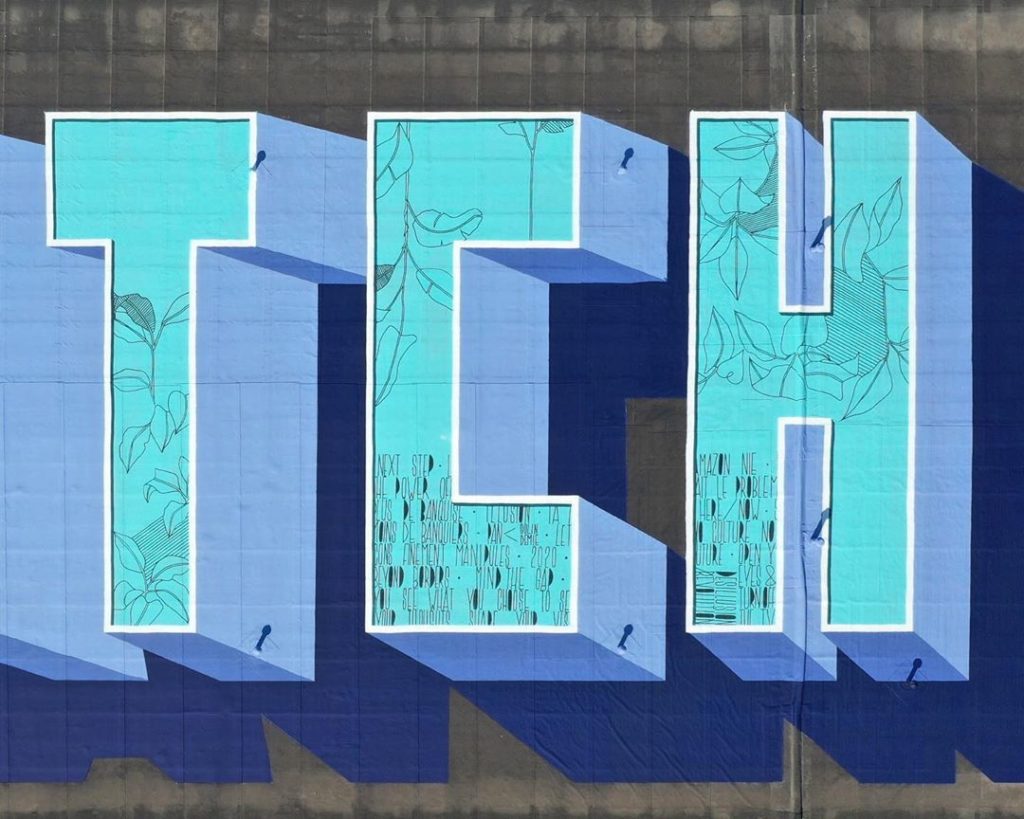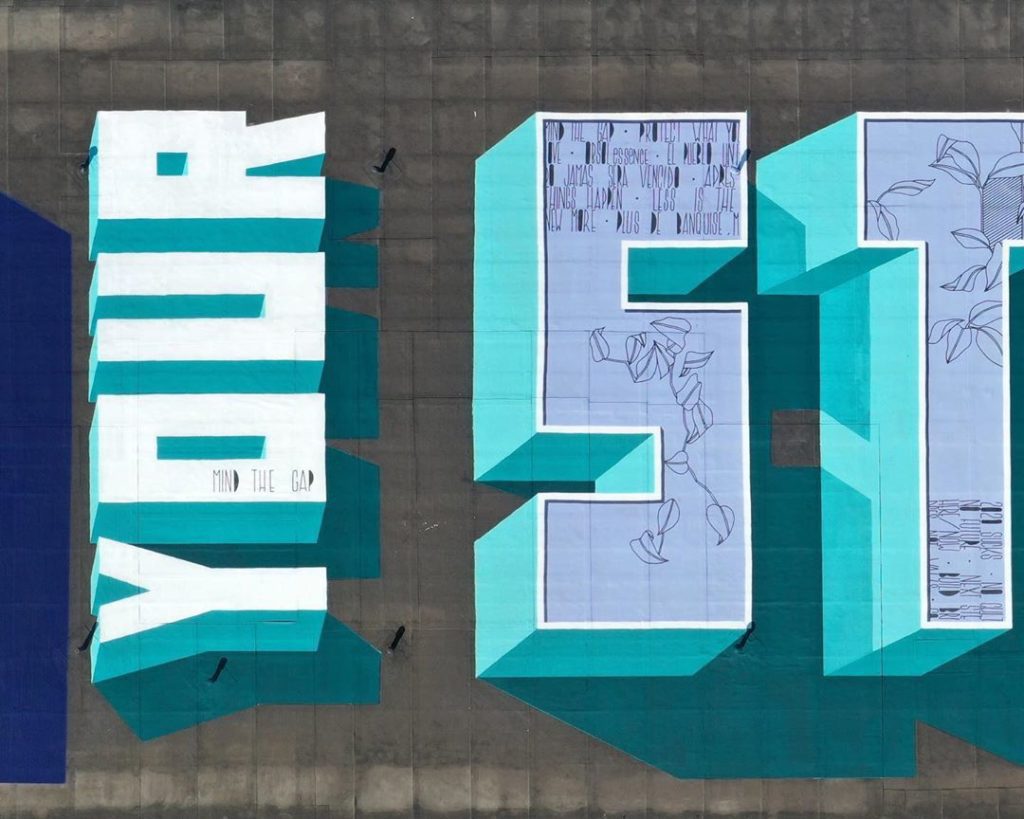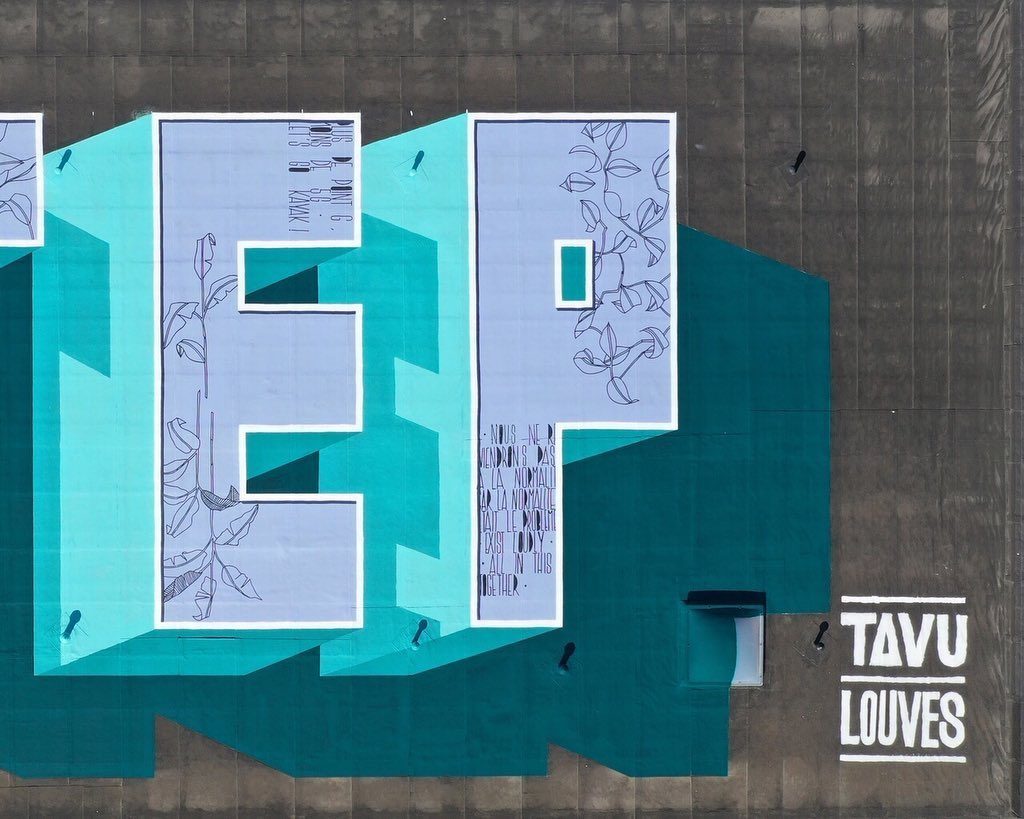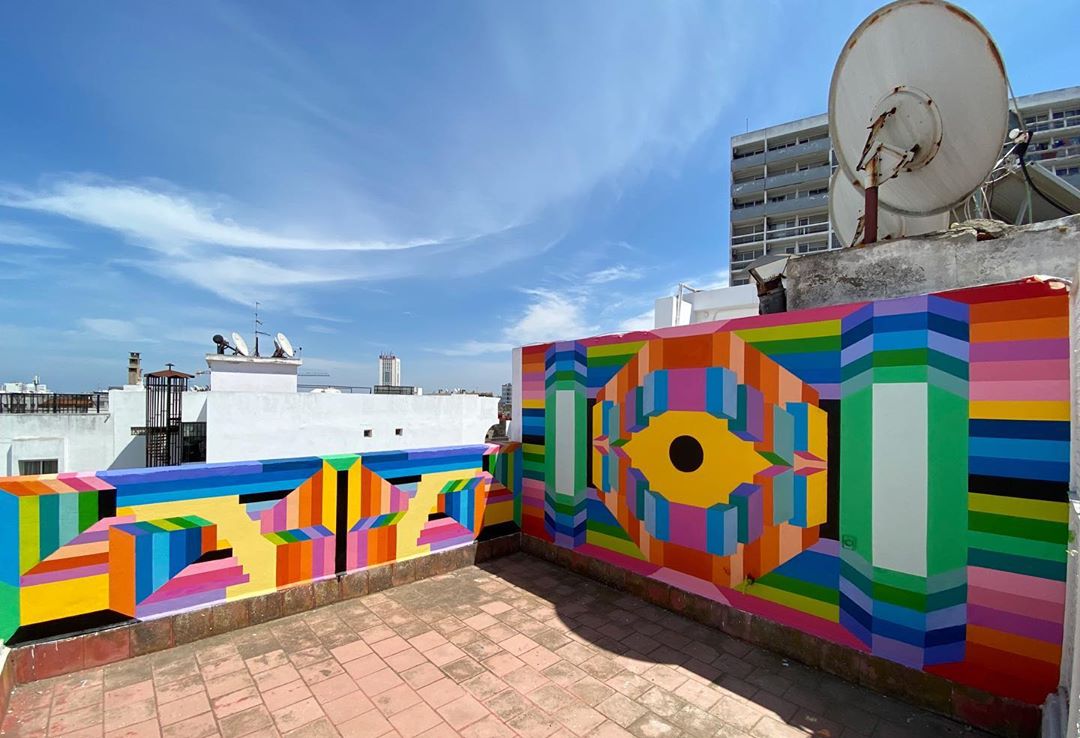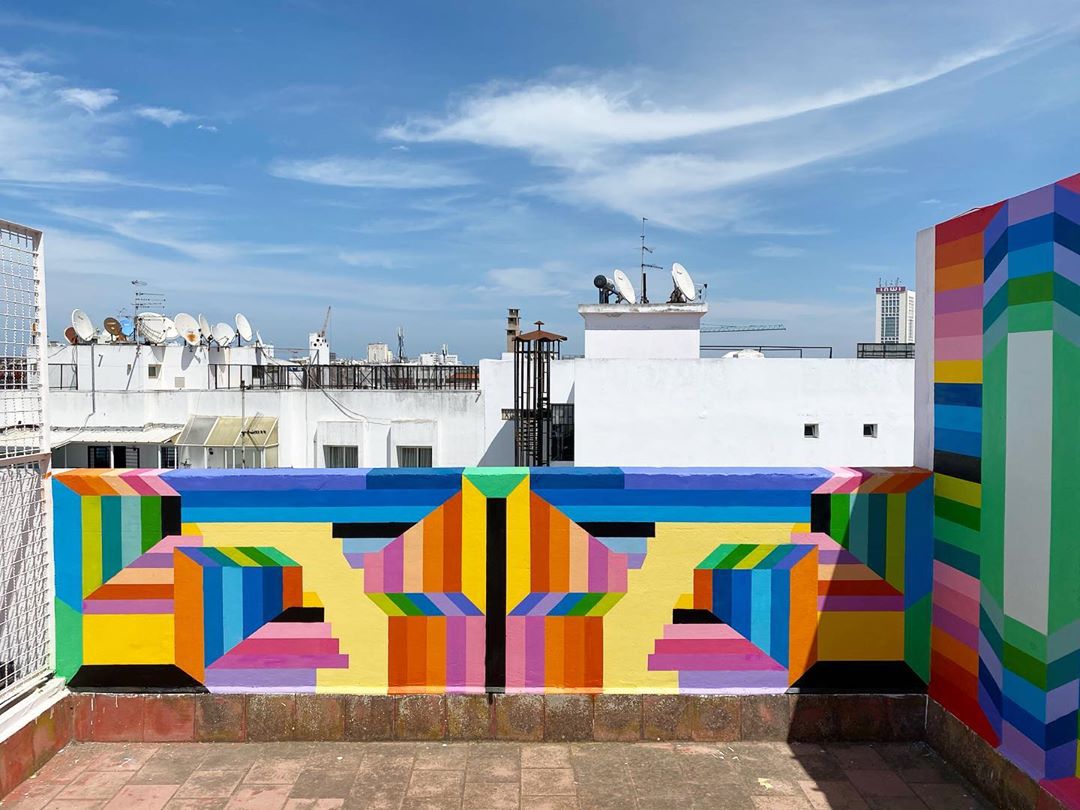In the past few years, we got used to seeing every week a bunch of freshly new painted walls by artists on the social media. Bali, New Dehli, Buenos Aires or LA… the most remote cities are the perfect frame for these large scale artworks.
But these last months have been different. A lot of projects have been postponed or cancelled and the impossibility of being out in the streets has made the number of new walls featured in Street Art blogs and social media to reduce drastically. However, there still are. Some artists have been caught up by the situation in the middle of the task, and others, due to the more permissive conditions in their cities, have been able to continue working.
Artist reflect about this crisis and go jump to the streets to do it in their favourite way: through paint and using the city wall as canvases. We gathered some of the murals made since March 2020 to the day. This is how artists think (and express themselves) during confinement.
Saype
Photo: Valentin Flauraud
Photo: Valentin Flauraud
Photo: Valentin Flauraud
Guillaume Legros or Saype (Belfort, France, 1989) has been revolutionizing the Urban Art world with his pieces halfway between ‘land art’ and graffiti. His gigantic frescoes made on grass with 100% biodegradable paint (which he prepares himself!) travel around the world every time he publishes an image on his social media. The works, explore the problems that concern humans, our place in this planet and in society. During the quarantine he has used the open field of the Swiss Alps in Leysin, close to where he lives, to create “Beyond Crisis”, a massive figure of a girl painting with chalks of about 3,000 m2. «It makes sense that we are all facing this crisis together. The splendid nature where this painting is located acts as an unbeatable setting to invite us to dream and look a little further. I hope it will make us think about the future in a more positive and optimistic way», Saype says.
Fitz Licuado (from duo Colectivo Licuado)
«During the past few months all the jobs we had locally and abroad have been cancelled, there was a complete change of agenda, a moving in the meantime … It was really a period of reconnecting with oneself, with the things that we had stopped doing for ourselves. For I while I hadn’t painted in the streets carrying my own stuff, my material and I went through a little crisis with mural painting, not knowing why I had disconnected with it or I was maybe just tired of seeing how the months passed without being able to paint», says Florencia Durán aka Fitz Licuado, one of the legs of the Uruguayan artistic ensemble Colectivo Licuado [which forms together with Camilo or Theic Licuado] on the wall she recently painted in the Old City of Montevideo. «I had taken some photos with my photographer friend Luli to Micaela, another friend… It was all very improvised and so was the impulse to go out and paint. I made the sketch, I put the colors together and the next day I was already painting it», continues. «The wall is located one block away from our studio. I love the neighborhood, I lived there for a while and I feel very comfortable, I have many friends. Painting this meant connecting with that more impulsive side of when Camilo and I started about ten or twelve years ago, when we would just go out and paint for the sake of it, so spontaneously. It’s been a while since the last time I was so happy with something personal that I’ve painted», she continues. «The message is not very deep or conceptual, it’s just a woman standing naked, with great strength, with a feather in her hand that shades her chest. It’s speaking about freedom and censorship through a game with the light. But I leave it to each one to interpretative it. The photos were taken with my own phone, I was planning to go take better ones but when I returned two days later someone had made some graffiti all around it. It is really rare, in the city we have several walls and it has never happened to us before. I also shared on my Instagram the photo with the graffiti on it and there was a very interesting debate with different opinions. Many colleagues were very angry but I just took it as things that happen, this is the street, you know». Her artistic work, with overflowing strength and an extraordinary sensitivity, are an ode to women and the feminine empowerment. Together with his artistic partner Camilo, they have led the Urban Art movement in Montevideo and representing it outside through making murals around the world representing the interaction between the human being and the environment where they are located.
Marat Morik
Foto: Vitaly Kim
Foto: Vitaly Kim
Foto: Vitaly Kim
The Russian artist, illustrator and graphic designer Marat Morik (Novosibirsk, 1982), now living in Prague, just finished his latest masterpiece to add on to his collection, in a small town in the middle of Russia called Neftekamsk for a project curated by Supernova Art Embassy. The mural with the name “Lost Childhood” is part of a project that celebrates historical memory of Victory Day (which celebrates the surrender of the Nazi Germany) and talks about the children who lost their innocence during World War II being forced to work hard in factories to support the Soviet army. «The topic is extremely complicated and I wanted to avoid direct associations with the terrors of the war and the sweet joy of victory. The work is dedicated to those children, who far from the front, had to grow up early, leaving their toys and children diversion behind to support their army at the machine factories», says Morik. In his murals he combines abstract and figurative techniques, mixed with realism and expressionism.
Bond TruLuv
Bond TruLuv at Stadt Wand. Foto: Alexander Krziwanie
Detail of Bond TruLuv wall at Stadt Wand. Foto: Alexander Krziwanie
Born and raised in Germany, Bond TruLuv (Göttingen, 1981) did his firsts moves into the graffiti world at the beginning of the 2000. Since then, he has committed himself to experiment with new ways of composing letters and other forms of calligraphic expression, mixing it with his knowledge in Fine Arts and Graphic Design. Considered a multimedia artist Bond TruLuv ir a true 3D illusions magician. After the lockdown was over, the artist painted “Stairway to Heaven” for the Stadt Wand Kunst festival, an outdoor Urban Art museum in the German city of Mannheim. A spectacular immersive 15 x10 meters mural using only spray paint and with an augmented reality technology activated by scanning the piece with the app “Artivive”. Bond TruLuv has actually been one of the first graffiti artists to incorporate augmented reality animations on his pieces, pushing the limits of Contemporary Urban Art and creating spectacularly vivid images.
Artez
Photo: Boris Vatovec
Photo: Boris Vatovec
Serbian artist Artez (Belgrade, 1988) known for his large-scale murals of delicate female figures finished his last major work a month ago. «By the end of April I finished a giant wall for an hotel that is under construction in Belgrade, my city. The wall is about 300 m2 and I have been very lucky to be able to continue working even during this quarantine period. It took me longer than expected because there were some problems with the scaffolding and it had to be reassembled … But I spent on it about 15 days in total». The artwork “Hometown” is inspired by the city of Belgrade with the sparrow, one of the main symbols of the Serbian capital, and the old fortress of the city drawn in the background.
Elian Chali
Still in March, when a few countries were going through one of the worst parts of the Covid crisis, in Latin America it seemed the pandemic was taking it and it seemed it would not hit as it did in Europe. It was in March when the Argentinian artist Elian Chali (1988, Córdoba) painted the 35×20 meter brick facade of the Mulen Hotel in Tandil, Argentina, using the primary colors and black that represent his work. After finishing it, the artist published on his social media a whole reflection on what was to come with the mandatory confinement. It is worth taking a read with an open mind: «This is the last work I did before mandatory confinement. Before our homes became franchises of the prison system. Before kisses started being a threat to the public hygiene. Before neighborhood authoritarianism washed citizen consciousness. Before mismanaging the stock of drugs for the confinement. Before mismanaging the stock of medicines. Before the junk content overdose. Before the preppy people would complain about themselves. Before the digitization of necro-politics. Before the overproduction of homemade bread. Before empathy sterilized by fear. Before TikTok organizes a mutant dance for us. Before the development of cyber-vigilance. Before we infect silence with noise. Before the romantic novel between Žižek and Byung-Chul Han. Before the health crisis becomes the pathologizing of desire. Before the worry of getting too fat out of the quarantine. Before the worry of starvation in quarantine. Before the regime of happiness soaps the anguish. Before we find out that there is a place called Wuhan. Before aseptic solidarity. Before the clock becomes an earthly countdown. Before looting toilet paper. Before the state of exception is vacations for some and a cemetery for others. Before the tutorial of the recreation. Before the narcotic effects of alcohol gel. Before the update of military sentiment. Before the balcony applause become a risky sport. Before Britney calls out for a general strike. Before the movie ‘El Hoyo’ or that awful version of ‘Imagine’. Before anything can be romanticized and that was a class privilege. Before emptying the gondolas. Before the latex caresses. Before overcrowding is also our martyrdom and not only of the animals, the psychiatrists or the prisoners. I did this work before all this, in a public space that may no longer exist. And your life, before what happened?», concludes. Worth giving it a thought.
Broken Fingaz
Photo: Yona Preminger
Photo: Yona Preminger
«Maybe it takes radical times like the ones we are now witnessing for us to realise things that once seemed solid as concrete are in fact fragile and transitory», reflect the members of Broken Fingaz, the crew from Haifa, Israel, on “This is Also Temporary”, their last mural made in Jerusalem under the framework of the “Walls Festival”. Accordingly to the style they’re known for, the Fingaz crew have worked on this mural with using the traditional 80’s aesthetics reminding of a ‘pulp’ style, using vignettes, thick lines and pop colors. With a controversial sense of humor, a sharp tongue and often explicit sex images, this group seeks to provoke a visceral reaction in the observer and has created a visual identity recognizable for a whole generation of young Israelis.
Tavu & Louves
Photos: Mathias Matteo / François Reunis / Thibault Rns
Belgian creative studios Tavu and Louves have teamed up to paint the nearly 1000m2 of the rooftop of the temporarily occupied building of the See U (Temporary Program U Square) space in Brussels. On this wall, only visible from the air, they have reflected the emergency of creating new habits for the coming society. Their motto? “We will not go back to normal, because normal was the problem.” Inside the letters “WATCH YOUR STEP” they have included a few messages of protest that seek to create a future with a greater social awareness. Among them you can read: “More G spot and less 5G”, “Project what you love”, “The united people will never be defeated”, “Here/Now”, “No culture, no future”, “2020 Sucks”,“ We are all in this together ”,“The power of youth”, “Beyond borders” or “Build bridges, not walls”.
Ghizlane Agzenai
Ghizlane Agzenai, Casablanca
«This is the final result of the two murals I’ve been painting on my rooftop this week. I feel grateful to have found this place to paint during these times of quarantine. Also I’ve painted it with an extra dose of love, optimism, hope and positive energy because that’s what we need lately. We will overcome all that’s happening because we are strong. Have Faith», says the artist born in Tanger and resident in Casablanca, Ghizlane Agzenai (Morocco, 1988). The geometric totems and the colors of his compositions transport us to a metaphysical dimension where one can freely express emotions and where each line, angle and color be interpreted in a different way according to the sensitivity of the viewer.

